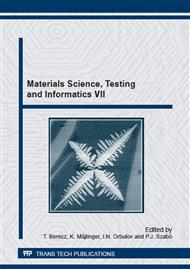p.181
p.189
p.195
p.201
p.207
p.213
p.219
p.227
p.233
Surface Properties of Lightweight Aggregate Concrete and its Correlation with Durability
Abstract:
Durability is one of most important requirements of concrete design. From this aspect is arising the required minimal compressive strength class of conventional concrete in order to ensure durability. The porosity of cement mortar matrix and consequently the liquid and gas permeability of concrete may be reduced. But the strength of lightweight aggregate concrete depends primarily on the crushing resistance of lightweight aggregate (LWA). With low strength LWA may be achieved higher concrete strength by high strength cement mortar matrix. Therefore we can not consider durability simply on the basis of the compressive strength of concrete. The most important durability factors are closely related to the porosity and strength of the cement mortar matrix but for example the abrasion resistance depends more significantly on the aggregate type. Lightweight aggregates usually do not have high abrasion resistance, but they can be advantageous in case of restoration of bridge pavement. The most important factors of durability regarding pavements are frost scaling and abrasion resistance. These parameters (especially abrasion resistance) are not available in the literature when using LWA.
Info:
Periodical:
Pages:
207-212
Citation:
Online since:
February 2015
Authors:
Price:
Сopyright:
© 2015 Trans Tech Publications Ltd. All Rights Reserved
Share:
Citation:


